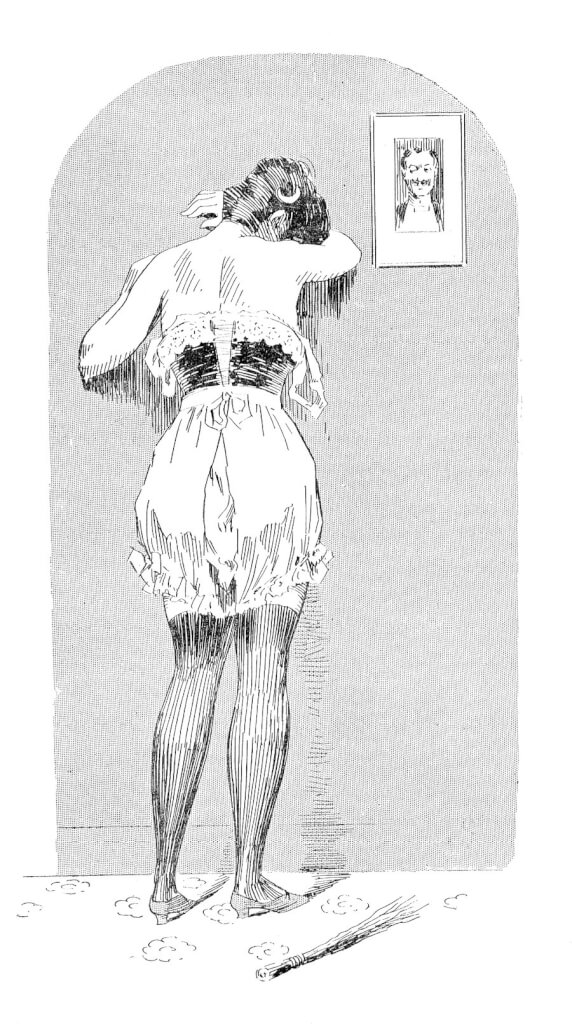-

 One Hundred Merrie and Delightsome Stories, ed. by Antoine de La Sale, trans. Robert B. Douglas (Charles Carrington, Paris, 1899 [first edition, first english translation]) 8" X 5.75", xxx 532pp, 3/4 tan morocco leather over marbled boards, gilt title on spine, 5 raised bands, marbled endpapers, excellent condition for age, ribbon intact, small tear at top of front cover. No illustrations One Hundred Merrie And Delightsome Stories (from the original French "Cent Nouvelles nouvelles" France, c. 1456-1461) is a collection of stories supposed to be narrated by various persons at the court of Philippe le Bon, and collected together by Antoine de la Sale in the mid 15th century. Charles Carrington was the first to have this translated into English. This edition does not contain the illustrations which were sold separately.
One Hundred Merrie and Delightsome Stories, ed. by Antoine de La Sale, trans. Robert B. Douglas (Charles Carrington, Paris, 1899 [first edition, first english translation]) 8" X 5.75", xxx 532pp, 3/4 tan morocco leather over marbled boards, gilt title on spine, 5 raised bands, marbled endpapers, excellent condition for age, ribbon intact, small tear at top of front cover. No illustrations One Hundred Merrie And Delightsome Stories (from the original French "Cent Nouvelles nouvelles" France, c. 1456-1461) is a collection of stories supposed to be narrated by various persons at the court of Philippe le Bon, and collected together by Antoine de la Sale in the mid 15th century. Charles Carrington was the first to have this translated into English. This edition does not contain the illustrations which were sold separately. -
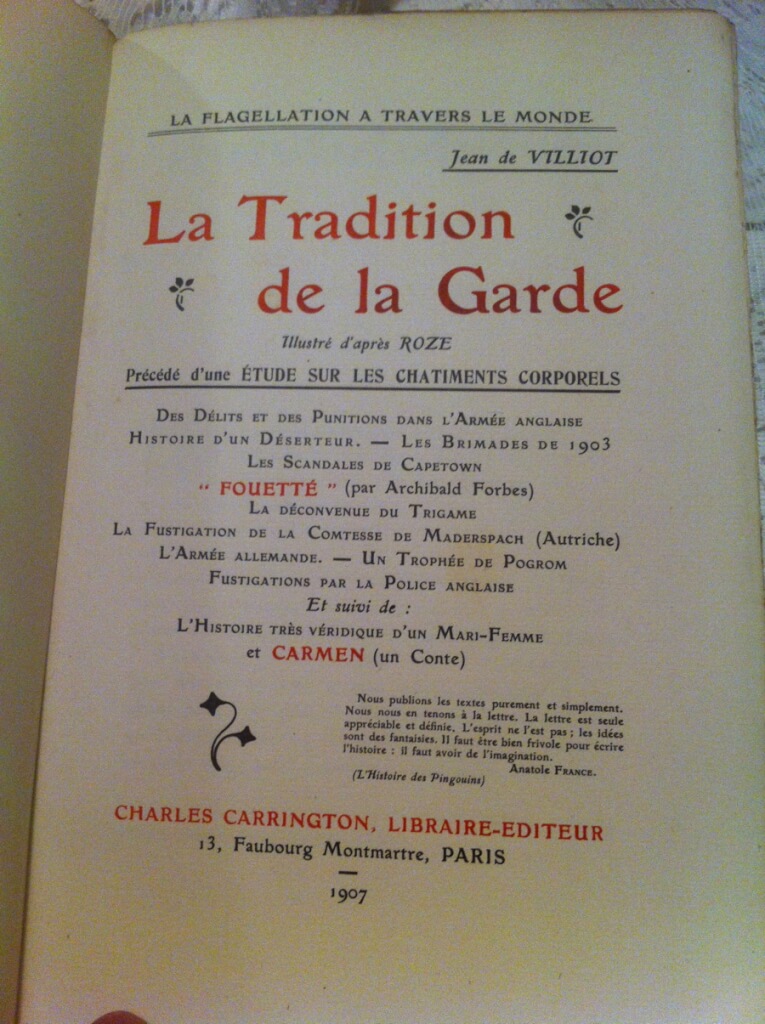
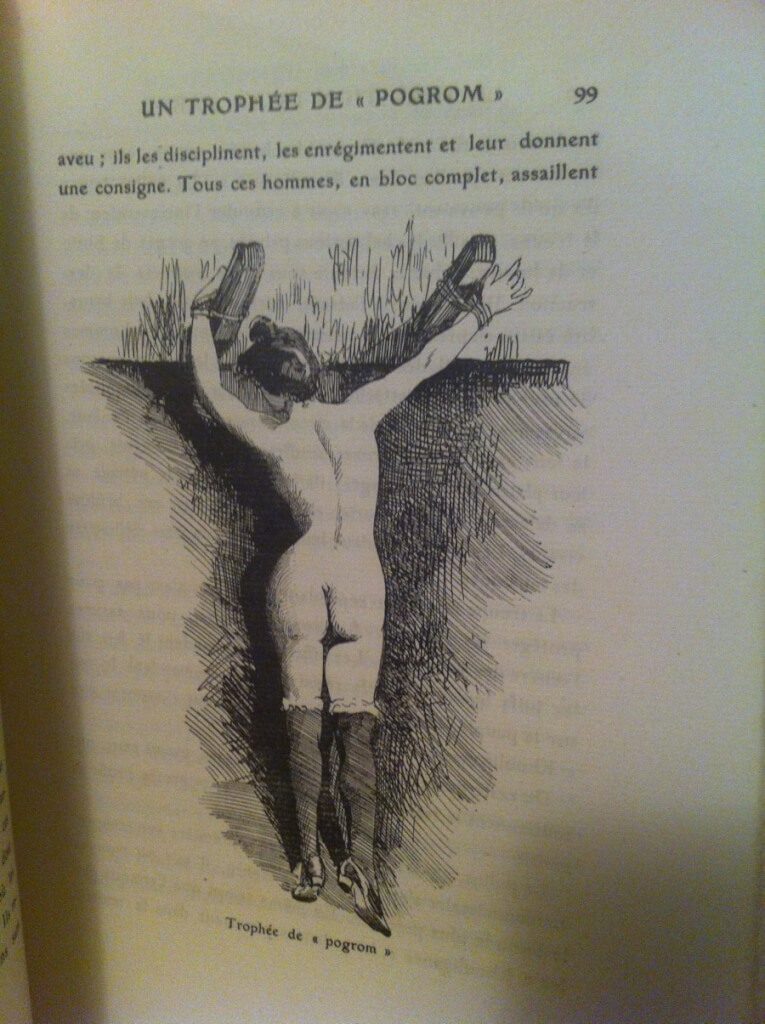 La Tradition de la Garde. Illustré d'après Roze. Précédé d'une étude sur les chatiments corporels. [Tradition of the Guard. Illustrated by Roze. Preceded by a study on corporal punishment.] by Jean de Villiot, [pseud. Georges Grassal de Choffat or Hugues Rebell], illus. Léon Roze (Charles Carrington, Paris, 1907, #244/700) 7.75" x 9.75", 209pp, very good condition for age, some light stains, soft covers and binding good, a rare, numerous illustrations
La Tradition de la Garde. Illustré d'après Roze. Précédé d'une étude sur les chatiments corporels. [Tradition of the Guard. Illustrated by Roze. Preceded by a study on corporal punishment.] by Jean de Villiot, [pseud. Georges Grassal de Choffat or Hugues Rebell], illus. Léon Roze (Charles Carrington, Paris, 1907, #244/700) 7.75" x 9.75", 209pp, very good condition for age, some light stains, soft covers and binding good, a rare, numerous illustrations -

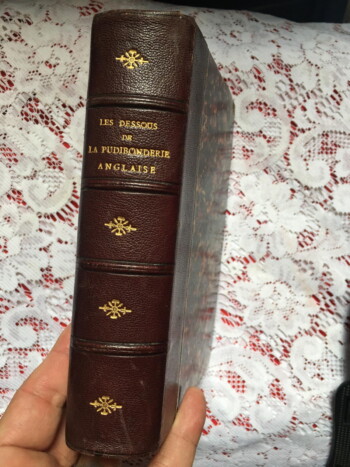 Les dessous de la pudibonderie anglaise expliqués dans les divorces anglais, ou procès en adultère jugés par le banc du Roi et la Cour Ecclésiastique d'Angleterre [trans. The Basics of English Prudishness Explained in English Divorces, or Adultery Trial Judged by the King's Bench and the Ecclesiastical Court of England], anonymous [most like Carrington himself as editor/compiler], illustrations Jacques Wely (Charles Carrington, Paris, 1898, first edition) 7.5"x5", 2 volumes in one, xxiv-108, xxx-287-xii, quarter morocco over marbled boards, 4 raised bands, gilt titles and decoration on spine, marbled endpapers, great condition, previous owners name on title page, some bumping to corners. According to the British Library this is a compilation of entries from "Trials for Adultry" [Trials for Adultery: or, the History of Divorces. Being Select Trials at Doctors Commons, for Adultery, Cruelty, Fornication, Impotence, &c. From the Year 1760, to the present Time. Including the whole of the Evidence on each Cause. Together with The Letters, &c. that have been intercepted between the amorous Parties… Taken in Short-Hand , by a Civilian. London: Printed for S. Bladon, 1779-1780] which, as the full title suggests, is considered one of the Earliest of "The Genre of Pornographic Trial Reports". Also present are excerpts from some English plays. According to Yale, this compillation also "Contains case histories from: Crim. con. biography attributed to Francis Plowden." London, 1798. Criminal conversation, commonly known as crim. con., is a tort arising from adultery, abolished in almost all jurisdictions. (Conversation is an old expression for sexual intercourse that is obsolete except as part of this term.) As far as we can tell, this is a book compiled and edited by Carrington. Carrington himself was an Englishman, a Londoner who was married to a woman from France. He published this book a few years after the couple left London and moved to Paris, presumably so he would have more freedom to publish books that London would have no doubt considered pornography. This book is a case study of the prudishness of the English and it uses salacious material taken from various sources listed above to prove the point.
Les dessous de la pudibonderie anglaise expliqués dans les divorces anglais, ou procès en adultère jugés par le banc du Roi et la Cour Ecclésiastique d'Angleterre [trans. The Basics of English Prudishness Explained in English Divorces, or Adultery Trial Judged by the King's Bench and the Ecclesiastical Court of England], anonymous [most like Carrington himself as editor/compiler], illustrations Jacques Wely (Charles Carrington, Paris, 1898, first edition) 7.5"x5", 2 volumes in one, xxiv-108, xxx-287-xii, quarter morocco over marbled boards, 4 raised bands, gilt titles and decoration on spine, marbled endpapers, great condition, previous owners name on title page, some bumping to corners. According to the British Library this is a compilation of entries from "Trials for Adultry" [Trials for Adultery: or, the History of Divorces. Being Select Trials at Doctors Commons, for Adultery, Cruelty, Fornication, Impotence, &c. From the Year 1760, to the present Time. Including the whole of the Evidence on each Cause. Together with The Letters, &c. that have been intercepted between the amorous Parties… Taken in Short-Hand , by a Civilian. London: Printed for S. Bladon, 1779-1780] which, as the full title suggests, is considered one of the Earliest of "The Genre of Pornographic Trial Reports". Also present are excerpts from some English plays. According to Yale, this compillation also "Contains case histories from: Crim. con. biography attributed to Francis Plowden." London, 1798. Criminal conversation, commonly known as crim. con., is a tort arising from adultery, abolished in almost all jurisdictions. (Conversation is an old expression for sexual intercourse that is obsolete except as part of this term.) As far as we can tell, this is a book compiled and edited by Carrington. Carrington himself was an Englishman, a Londoner who was married to a woman from France. He published this book a few years after the couple left London and moved to Paris, presumably so he would have more freedom to publish books that London would have no doubt considered pornography. This book is a case study of the prudishness of the English and it uses salacious material taken from various sources listed above to prove the point. -

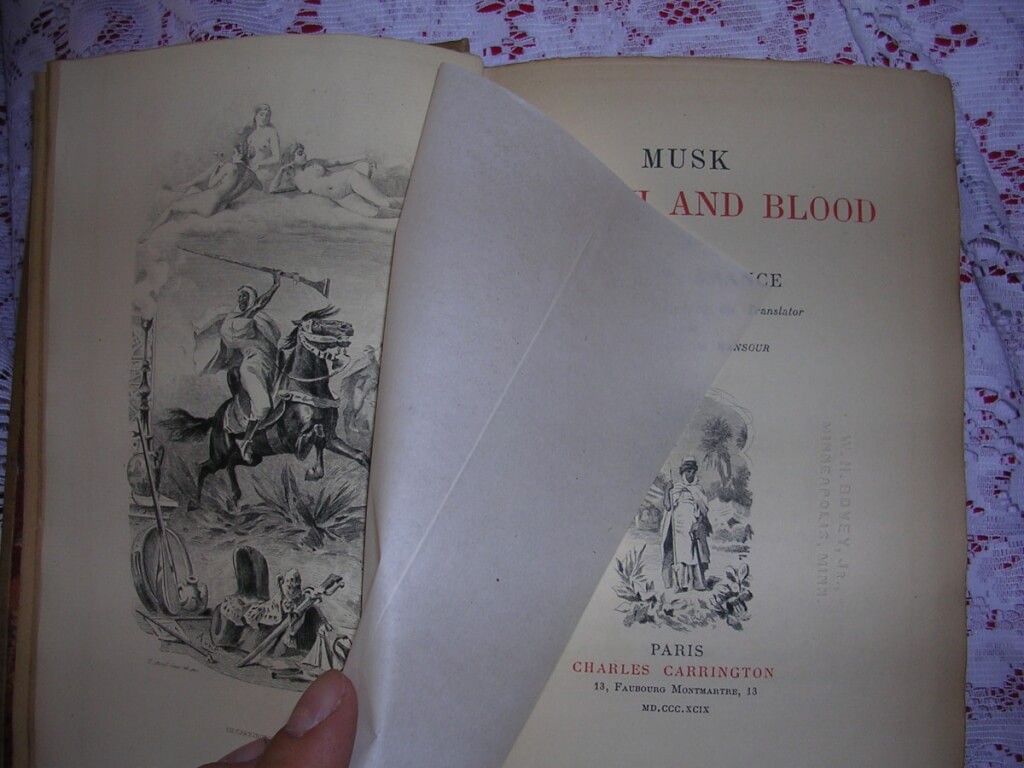 Musk, Hashish and Blood, Hector France, illust. Paul Avril, [trans. most likely Alfred Richard Allinson] (Charles Carrington, Paris, 1899) 8.5" X 5.5", xiii 447pp., hardbound, cloth boards with gilt tittles and decorations. Marbled end papers, deckled edges, frontispiece with tissue guard and numerous illustrations throughout. Good condition, binding is cocked but intact. Owner's signature in front, ink stamp in back, and imprint on title page reads "W.H. Bovey, Minneapolis, MN." Hector France (1837 - 1908) was a French author best known for his "orientalist" and flagellation tales. This graphic and exciting picture of the Algerian desert, its tribes and their astounding customs is a sensational recounting of France's experiences in North Africa. France tells the stories of his adventures in the nineteenth century Arab world from an eyewitness view. "The adventures of a modern man among the cruel men and passionate women of Algiers." Édouard-Henri Avril (1849-1928) used the pseudonym "Paul Avril" for his erotic work. He was a French painter and commercial artist. His career saw collaboration with influential people like Octave Uzanne, Henry Spencer Ashbee and Friedrich Karl Forberg. He is one of the most celebrated erotic artists of his age. Avril was a soldier before starting his career in art. He was awarded with the Legion of Honour for his actions in the Franco-Prussian War.
Musk, Hashish and Blood, Hector France, illust. Paul Avril, [trans. most likely Alfred Richard Allinson] (Charles Carrington, Paris, 1899) 8.5" X 5.5", xiii 447pp., hardbound, cloth boards with gilt tittles and decorations. Marbled end papers, deckled edges, frontispiece with tissue guard and numerous illustrations throughout. Good condition, binding is cocked but intact. Owner's signature in front, ink stamp in back, and imprint on title page reads "W.H. Bovey, Minneapolis, MN." Hector France (1837 - 1908) was a French author best known for his "orientalist" and flagellation tales. This graphic and exciting picture of the Algerian desert, its tribes and their astounding customs is a sensational recounting of France's experiences in North Africa. France tells the stories of his adventures in the nineteenth century Arab world from an eyewitness view. "The adventures of a modern man among the cruel men and passionate women of Algiers." Édouard-Henri Avril (1849-1928) used the pseudonym "Paul Avril" for his erotic work. He was a French painter and commercial artist. His career saw collaboration with influential people like Octave Uzanne, Henry Spencer Ashbee and Friedrich Karl Forberg. He is one of the most celebrated erotic artists of his age. Avril was a soldier before starting his career in art. He was awarded with the Legion of Honour for his actions in the Franco-Prussian War. -
Out of stock
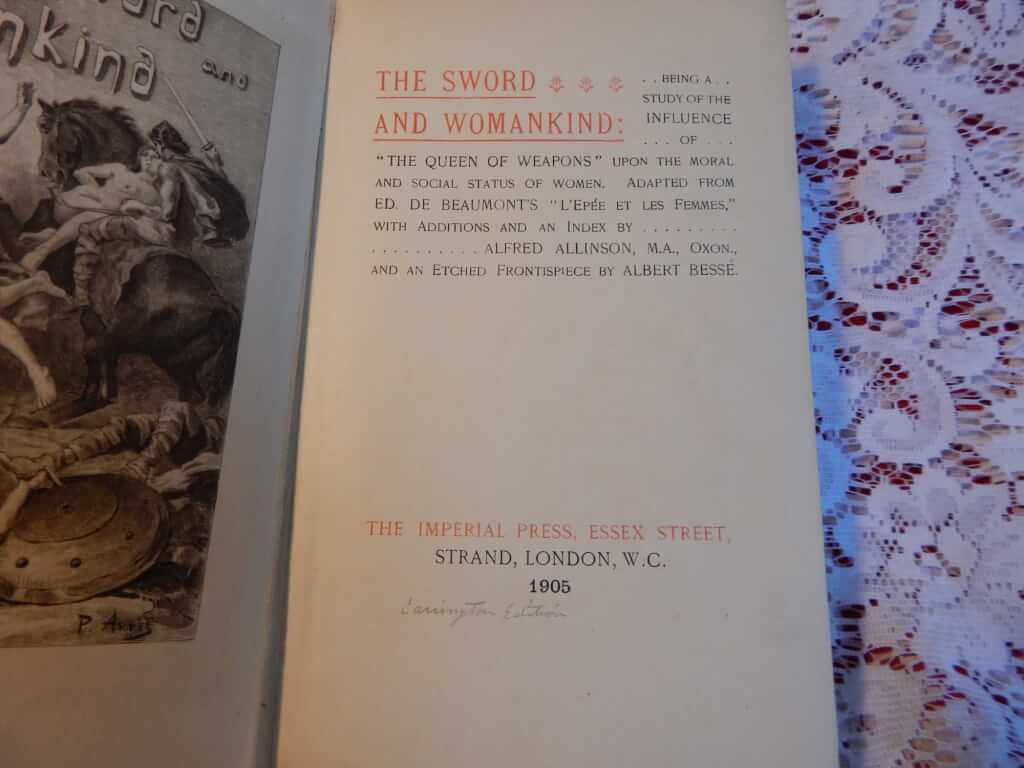
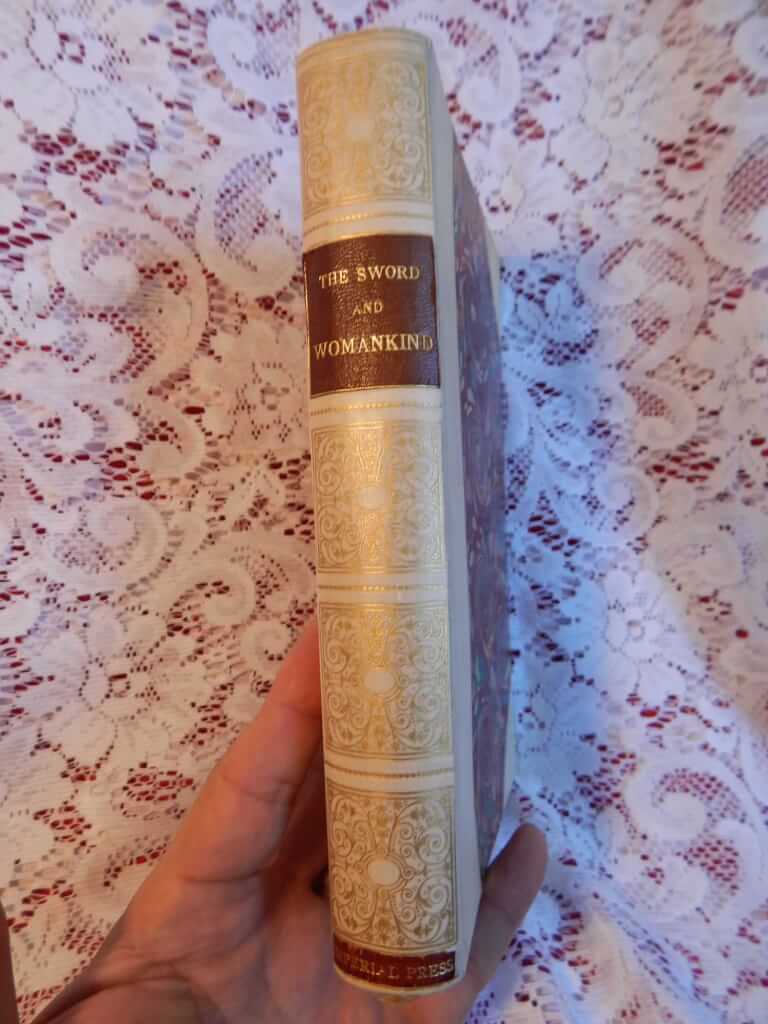 The Sword and Womankind: being a study of the influence of "The Queen of Wepons" upon the moral and social status of women. Adapted from Ed. de Beauont's "L'Epée et les Femmes," with addtions and an index by Alfred Allinson, M.A. Oxon., and an etched frontispiece by Albert Bessé, [frontispiece actually by Paul Avril, engraved by E. Leon] (The Imperial Press [Charles Carrington], Essex Street, Strand, London, W.C., 1905, #487/1000) 5.75"x8.75", xx+410pp, 1/2 while vellum over marbled boards, gilt title and decorations on spine, marbled endpapers, top edge gilt others deckled, frontispiece features a rare Paul Avril print and NOT Albert Bessé, numerous notes written lightly in margins in pencil, ribbon present, near fine copy, owner's ex libris stamp is evident on a few pages Beaumont, with a characteristic French point of view, believes in a feminine interpretation of history - which is, that all important historic events are caused by women. But unlike most Frenchmen he believed that all such events are caused by naughty women. This is a history of those women, adapted from the original French. Sample chapters: In barbarous ages woman is a divinity - Frea, the Scandinavian Venus; Swordsmen become the agents of women's sexual excesses - public defiances concerning harlots; Debauchery during the crusades - chivalry modified by oriental passions; New ways of love and dalliance - interest in salacious art. History of consequences of gender and sex including degradation of women, concubines, chastity belts, prostitutes, debauchery during crusades, erotic literature, duelists, cavaliers, orgies, etc. The book repeatedly advises that it is privately printed for subscribers only which was a legal fiction designed to get around obscenity laws prohibiting the public sale of such books. Édouard-Henri Avril (1849-1928) used the pseudonym “Paul Avril” for his erotic work. He was a French painter and commercial artist. His career saw collaboration with influential people like Octave Uzanne, Henry Spencer Ashbee and Friedrich Karl Forberg. He is one of the most celebrated erotic artists of his age. Avril was a soldier before starting his career in art. He was awarded with the Legion of Honour for his actions in the Franco-Prussian War.
The Sword and Womankind: being a study of the influence of "The Queen of Wepons" upon the moral and social status of women. Adapted from Ed. de Beauont's "L'Epée et les Femmes," with addtions and an index by Alfred Allinson, M.A. Oxon., and an etched frontispiece by Albert Bessé, [frontispiece actually by Paul Avril, engraved by E. Leon] (The Imperial Press [Charles Carrington], Essex Street, Strand, London, W.C., 1905, #487/1000) 5.75"x8.75", xx+410pp, 1/2 while vellum over marbled boards, gilt title and decorations on spine, marbled endpapers, top edge gilt others deckled, frontispiece features a rare Paul Avril print and NOT Albert Bessé, numerous notes written lightly in margins in pencil, ribbon present, near fine copy, owner's ex libris stamp is evident on a few pages Beaumont, with a characteristic French point of view, believes in a feminine interpretation of history - which is, that all important historic events are caused by women. But unlike most Frenchmen he believed that all such events are caused by naughty women. This is a history of those women, adapted from the original French. Sample chapters: In barbarous ages woman is a divinity - Frea, the Scandinavian Venus; Swordsmen become the agents of women's sexual excesses - public defiances concerning harlots; Debauchery during the crusades - chivalry modified by oriental passions; New ways of love and dalliance - interest in salacious art. History of consequences of gender and sex including degradation of women, concubines, chastity belts, prostitutes, debauchery during crusades, erotic literature, duelists, cavaliers, orgies, etc. The book repeatedly advises that it is privately printed for subscribers only which was a legal fiction designed to get around obscenity laws prohibiting the public sale of such books. Édouard-Henri Avril (1849-1928) used the pseudonym “Paul Avril” for his erotic work. He was a French painter and commercial artist. His career saw collaboration with influential people like Octave Uzanne, Henry Spencer Ashbee and Friedrich Karl Forberg. He is one of the most celebrated erotic artists of his age. Avril was a soldier before starting his career in art. He was awarded with the Legion of Honour for his actions in the Franco-Prussian War. -
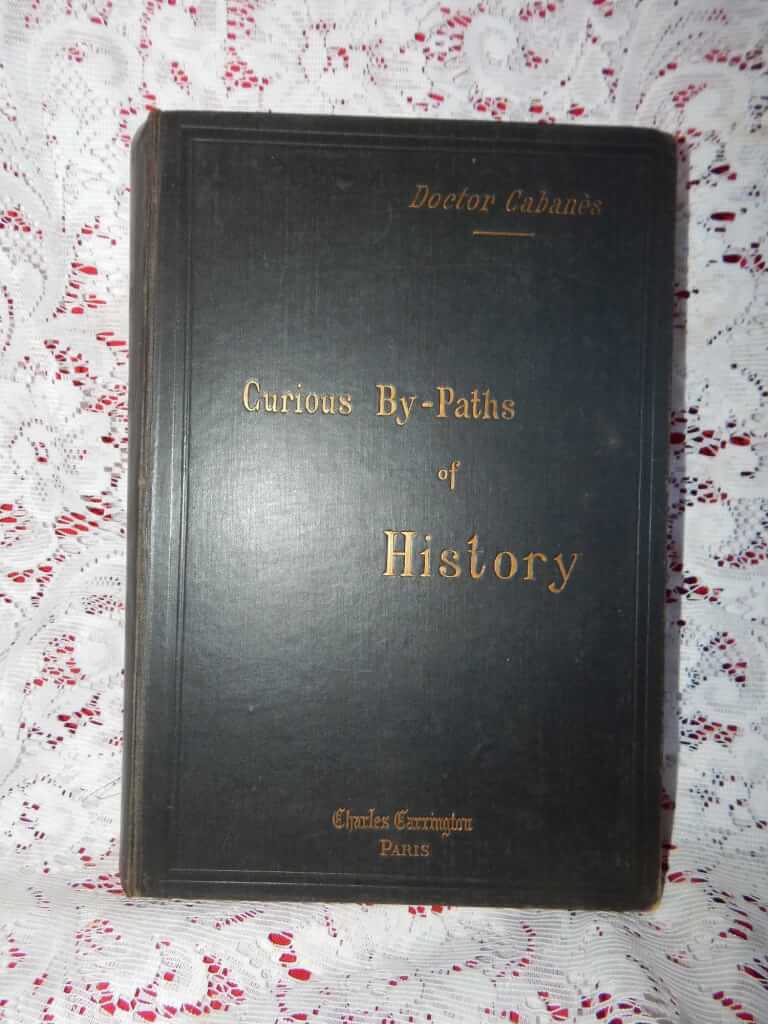
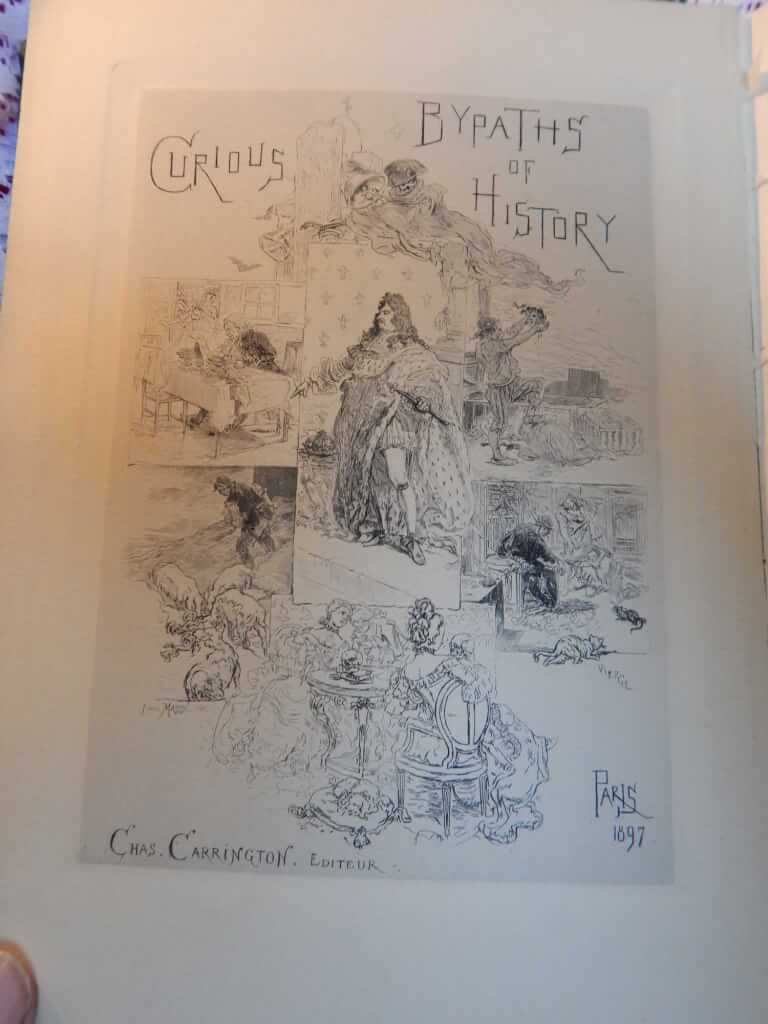 Curious Bypaths of History: Being Medico-Historical Studies and Observations, by Dr. [Augustin] Cabanès, frontispiece by Daniel Vierge engraved on copper by F. Massé (Librairie Des Bibliophiles, Charles Carrington, Éditeur, Paris 1898, #238/500) 7"x10", xx+367pp, black cloth with gilt titles on cover and spine (spine titles faded), front boards loose but holding, marbled endpapers, printed on "Van Gelder's vellum paper", gilt top edge, other edges deckled. Charles Carrington published a series of 3 books looking into the private lives of the French aristocracy titled, "Pathological studies of the past". The books are Secret Cabinet of History Peeped into By a Doctor (1897), Curious Bypaths of History: Being Medico-Historical Studies and Observations (1898), Flagellation in France from a medical and historical standpoint (1898). The first two and possibly the third were written by Dr. Augustin Cabanès (1862-1928), a French doctor, historian and author. Contents of this book, Curious Bypaths of History, include: The Teeth of Louis Xi, The Clandestine Accouchements of Mdlle De La Valliere (Louise de La Vallière was a mistress of Louis XIV of France from 1661 to 1667.), Illustrious Remains And Anatomical Relics. — the Skeleton of Mme De Maintenon And the Skull of Mme De Sevigne, The Infirmities of Sophie Arnould (a very popular French operatic soprano), Was Dr. Guillotin the Inventor Or the God-Father, of the Guillotine?, the Real Charlotte Corday. — Her Personal Appearance (Marie-Anne Charlotte de Corday d'Armont was a figure of the French Revolution. In 1793, she was executed by guillotine for the assassination of Jacobin leader Jean-Paul Marat, who was in part responsible for the more radical course the Revolution had taken through his role as a politician and journalist.), The Superstitions of Napoleon I, A Romance With Three Actors: Alfred De Musset, George Sand, And Doctor Pagello.
Curious Bypaths of History: Being Medico-Historical Studies and Observations, by Dr. [Augustin] Cabanès, frontispiece by Daniel Vierge engraved on copper by F. Massé (Librairie Des Bibliophiles, Charles Carrington, Éditeur, Paris 1898, #238/500) 7"x10", xx+367pp, black cloth with gilt titles on cover and spine (spine titles faded), front boards loose but holding, marbled endpapers, printed on "Van Gelder's vellum paper", gilt top edge, other edges deckled. Charles Carrington published a series of 3 books looking into the private lives of the French aristocracy titled, "Pathological studies of the past". The books are Secret Cabinet of History Peeped into By a Doctor (1897), Curious Bypaths of History: Being Medico-Historical Studies and Observations (1898), Flagellation in France from a medical and historical standpoint (1898). The first two and possibly the third were written by Dr. Augustin Cabanès (1862-1928), a French doctor, historian and author. Contents of this book, Curious Bypaths of History, include: The Teeth of Louis Xi, The Clandestine Accouchements of Mdlle De La Valliere (Louise de La Vallière was a mistress of Louis XIV of France from 1661 to 1667.), Illustrious Remains And Anatomical Relics. — the Skeleton of Mme De Maintenon And the Skull of Mme De Sevigne, The Infirmities of Sophie Arnould (a very popular French operatic soprano), Was Dr. Guillotin the Inventor Or the God-Father, of the Guillotine?, the Real Charlotte Corday. — Her Personal Appearance (Marie-Anne Charlotte de Corday d'Armont was a figure of the French Revolution. In 1793, she was executed by guillotine for the assassination of Jacobin leader Jean-Paul Marat, who was in part responsible for the more radical course the Revolution had taken through his role as a politician and journalist.), The Superstitions of Napoleon I, A Romance With Three Actors: Alfred De Musset, George Sand, And Doctor Pagello. -
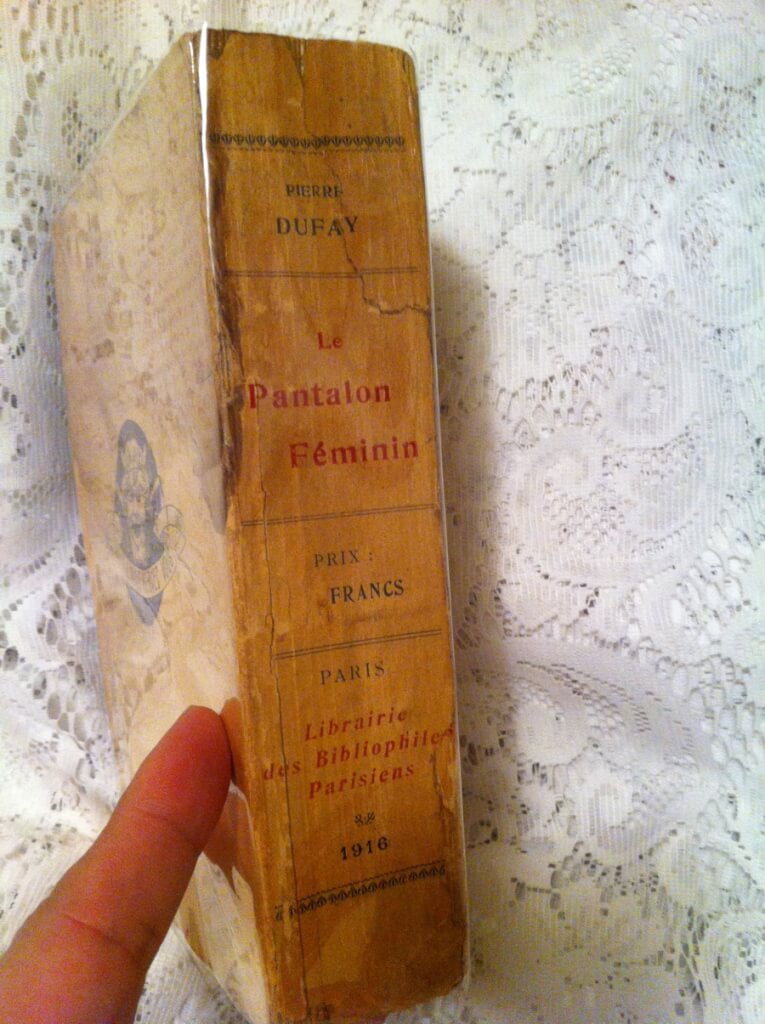
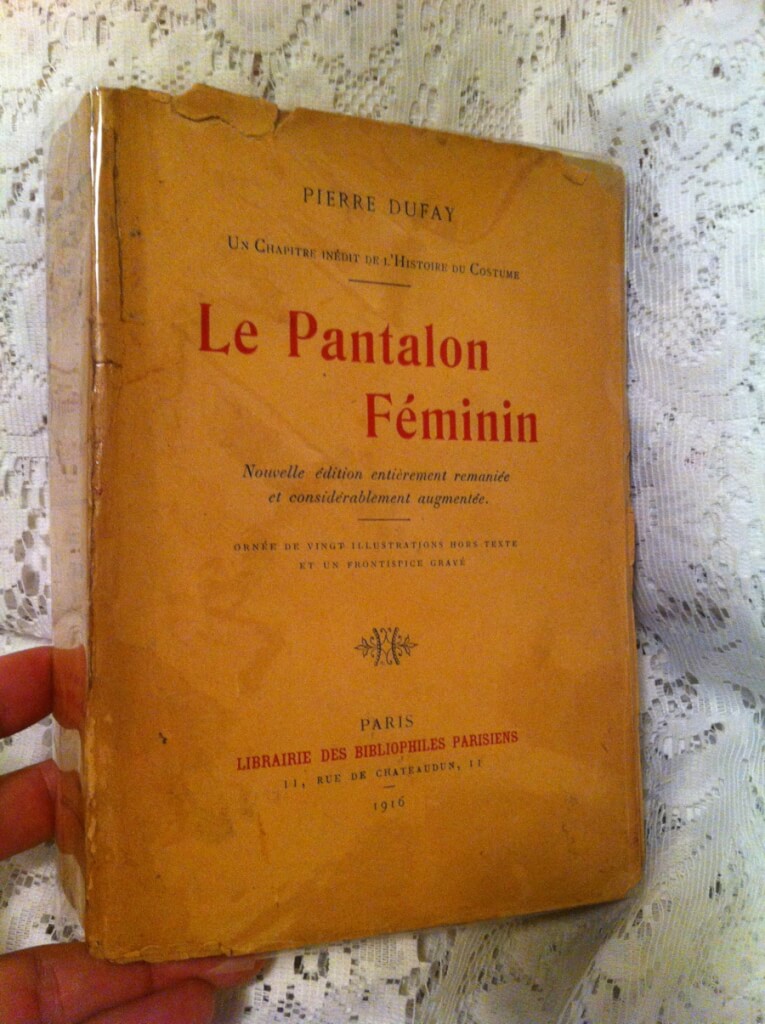 Le Pantalon Féminin (Un chapitre inédit de l'Histoire du Costume) by Pierre Dufay, preface by d'Armand Silvestre (Charles Carrington, Librairie Des Bibliophiles Parisiens, 1916, Paris) 7.75" X 5.75", xv 584pp., original soft wraps protected by a clear archival dust cover. Deckled edges. Some pages remain uncut. Index, table of contents, errata, and 5 pages of ads in the back. Good condition for age, some tears to the edges of cover, stain on the back. A rare find with it's illustrations intact.
Le Pantalon Féminin (Un chapitre inédit de l'Histoire du Costume) by Pierre Dufay, preface by d'Armand Silvestre (Charles Carrington, Librairie Des Bibliophiles Parisiens, 1916, Paris) 7.75" X 5.75", xv 584pp., original soft wraps protected by a clear archival dust cover. Deckled edges. Some pages remain uncut. Index, table of contents, errata, and 5 pages of ads in the back. Good condition for age, some tears to the edges of cover, stain on the back. A rare find with it's illustrations intact. -
 Musk, Hashish and Blood, Hector France, illust. Paul Avril, [trans. most likely Alfred Richard Allinson] (Walpole Press [identical to the 1899 Charles Carrington edition], London and Paris, 1900) 8.5″ X 5.5″, xiii 447pp., hardbound, green boards with gilt tittles and decorations, top-edge gilt others deckled, frontispiece with tissue guard and numerous illustrations throughout. Good condition, label pasted on the last page states “Charles Carrington, 13, Faubourg Montmartre, 13, Paris. IX.” Hector France (1837 - 1908) was a French author best known for his "orientalist" and flagellation tales. This graphic and exciting picture of the Algerian desert, its tribes and their astounding customs is a sensational recounting of France's experiences in North Africa. France tells the stories of his adventures in the nineteenth century Arab world from an eyewitness view. "The adventures of a modern man among the cruel men and passionate women of Algiers." Édouard-Henri Avril (1849-1928) used the pseudonym "Paul Avril" for his erotic work. He was a French painter and commercial artist. His career saw collaboration with influential people like Octave Uzanne, Henry Spencer Ashbee and Friedrich Karl Forberg. He is one of the most celebrated erotic artists of his age. Avril was a soldier before starting his career in art. He was awarded with the Legion of Honour for his actions in the Franco-Prussian War.
Musk, Hashish and Blood, Hector France, illust. Paul Avril, [trans. most likely Alfred Richard Allinson] (Walpole Press [identical to the 1899 Charles Carrington edition], London and Paris, 1900) 8.5″ X 5.5″, xiii 447pp., hardbound, green boards with gilt tittles and decorations, top-edge gilt others deckled, frontispiece with tissue guard and numerous illustrations throughout. Good condition, label pasted on the last page states “Charles Carrington, 13, Faubourg Montmartre, 13, Paris. IX.” Hector France (1837 - 1908) was a French author best known for his "orientalist" and flagellation tales. This graphic and exciting picture of the Algerian desert, its tribes and their astounding customs is a sensational recounting of France's experiences in North Africa. France tells the stories of his adventures in the nineteenth century Arab world from an eyewitness view. "The adventures of a modern man among the cruel men and passionate women of Algiers." Édouard-Henri Avril (1849-1928) used the pseudonym "Paul Avril" for his erotic work. He was a French painter and commercial artist. His career saw collaboration with influential people like Octave Uzanne, Henry Spencer Ashbee and Friedrich Karl Forberg. He is one of the most celebrated erotic artists of his age. Avril was a soldier before starting his career in art. He was awarded with the Legion of Honour for his actions in the Franco-Prussian War. -

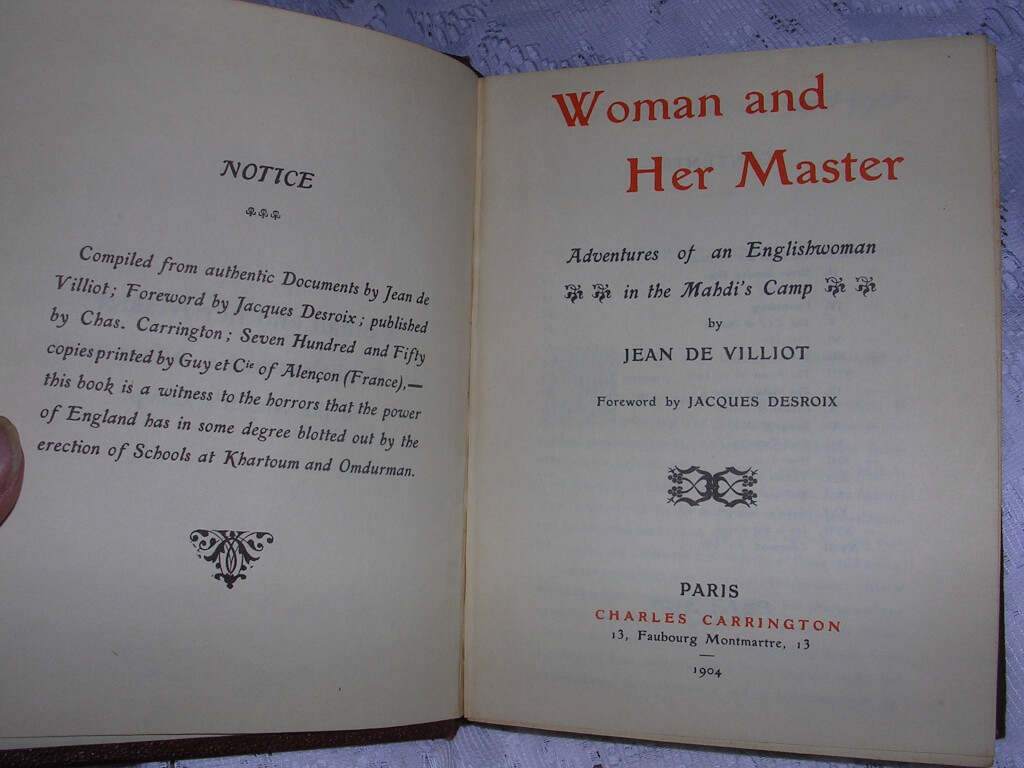 Woman and her Master; an Englishwoman's Adventures in the Madhi's Camp, Jean de Villiot [George Grassal (Hugues Rebell)] (Charles Carrington, Paris, 1904 [printed "Alençon, Imprimerie Veuve Félix Guy et Cie"] stated limited edition 750 copies) 6 3/8" X 5", 301pp, hardbound, red pebbled cloth boards, gilt title on front, no writing on spine, sewn signatures, good condition, some minor bumping and rubbing Jean de Villiot was a pseudonym used by several authors and compilers working for the publisher Charles Carrington writing novels and "studies" concerning flagellation, including Hugues Rebell (Georges Grassal), Hector France, Stéphane Arnoulin and Charles Carrington, himself. This novel is attributed to George Grassal (Hugues Rebell) originally written in French, in 1902, as "La Femme et son maître" (The Woman and her Master). In 1904 "Woman and her Master" was published in English by Charles Carrington. Often these editions were printed unbound and sent to the bookseller to bind to the specifications of their customers. "this book is a witness to the horrors that the power of England has in some degree blotted out by the erection of Schools at Khartoum and Omdurman."
Woman and her Master; an Englishwoman's Adventures in the Madhi's Camp, Jean de Villiot [George Grassal (Hugues Rebell)] (Charles Carrington, Paris, 1904 [printed "Alençon, Imprimerie Veuve Félix Guy et Cie"] stated limited edition 750 copies) 6 3/8" X 5", 301pp, hardbound, red pebbled cloth boards, gilt title on front, no writing on spine, sewn signatures, good condition, some minor bumping and rubbing Jean de Villiot was a pseudonym used by several authors and compilers working for the publisher Charles Carrington writing novels and "studies" concerning flagellation, including Hugues Rebell (Georges Grassal), Hector France, Stéphane Arnoulin and Charles Carrington, himself. This novel is attributed to George Grassal (Hugues Rebell) originally written in French, in 1902, as "La Femme et son maître" (The Woman and her Master). In 1904 "Woman and her Master" was published in English by Charles Carrington. Often these editions were printed unbound and sent to the bookseller to bind to the specifications of their customers. "this book is a witness to the horrors that the power of England has in some degree blotted out by the erection of Schools at Khartoum and Omdurman." -
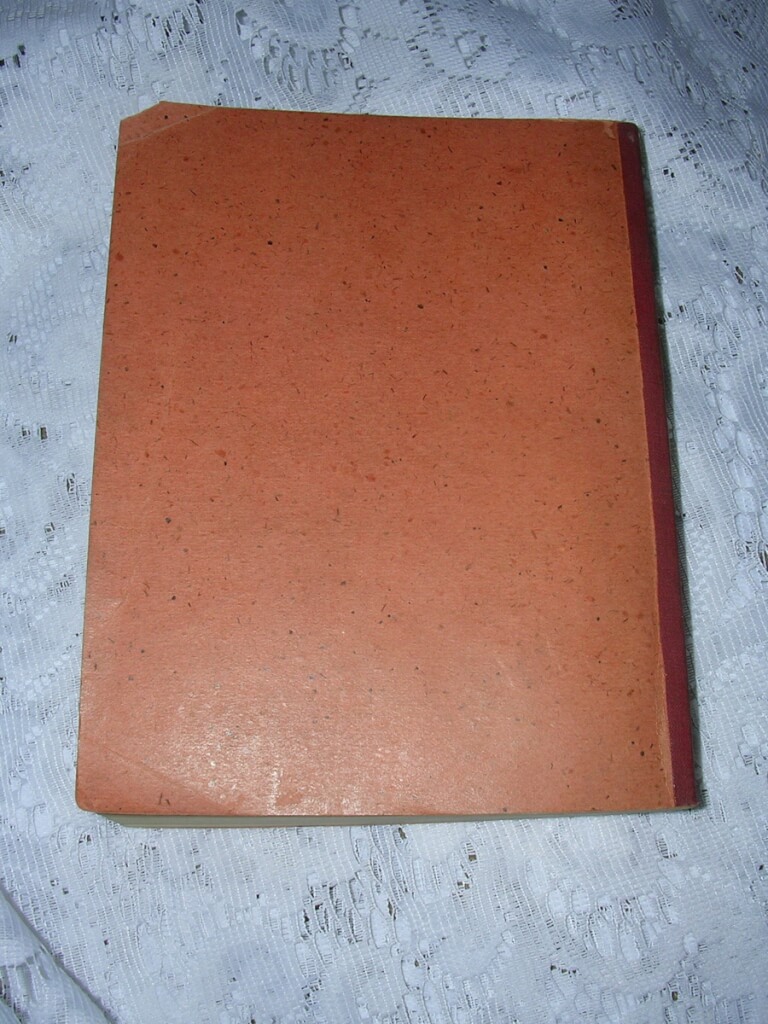
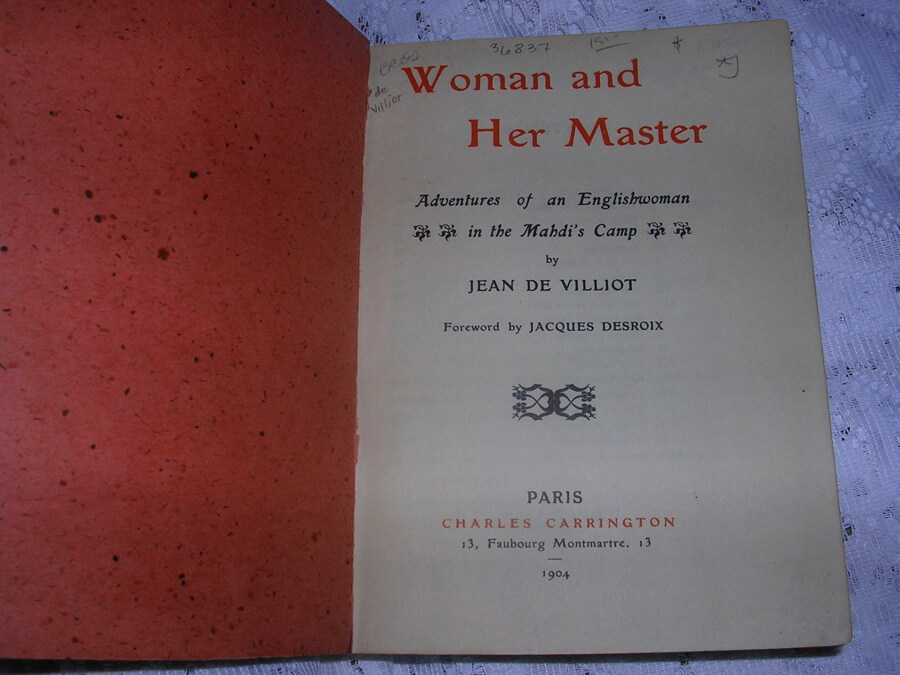 Jean de Villiot [George Grassal (Hugues Rebell)] (Charles Carrington, Paris, 1904 [printed "Alençon, Imprimerie Veuve Félix Guy et Cie"]) 6 3/8" X 5", 301pp, soft bound, red cloth spine with titling to paper label, orange paper covers, good condition, crease in lower corner of cover and inch tear along gutter's edge, slightly yellow pages
Jean de Villiot [George Grassal (Hugues Rebell)] (Charles Carrington, Paris, 1904 [printed "Alençon, Imprimerie Veuve Félix Guy et Cie"]) 6 3/8" X 5", 301pp, soft bound, red cloth spine with titling to paper label, orange paper covers, good condition, crease in lower corner of cover and inch tear along gutter's edge, slightly yellow pages -
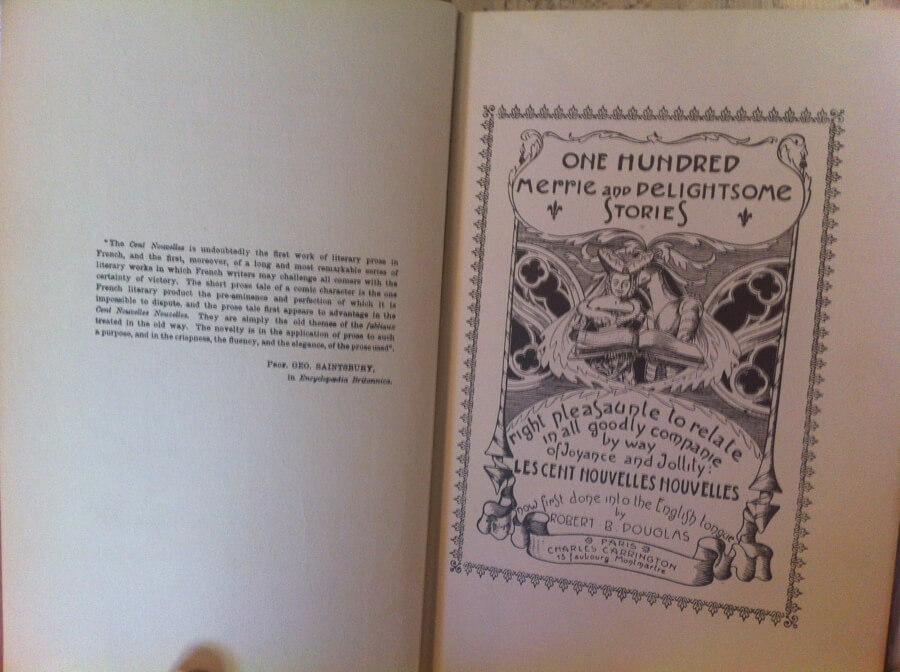
 One Hundred Merrie and Delightsome Stories, ed. by Antoine de La Sale, trans. Robert B. Douglas (Charles Carrington, Paris, 1899 [pirated facimile reprint, probably New York, c.1930 states "privately printed from the Charles Carrington Paris 1899 edition] #294/1250) 8" X 5.75", two volumes, xxx+532pp, pagination continuous. Fifty-two b&w plates by Léon Lebègue, marbled boards, gilt on spine, top edge gilt, other edges deckled, very good condition, minor bumping, some stains on front cover of vol. 2 Charles Carrington was the first to have this translated into English. This is a pirated copy, but still very nicely printed on good paper, the illustrations are in B&W. Purported a collection of short stories narrated by various persons at the court of Philippe le Bon, and collected together by Antoine de la Sale, the nouvelles are, according to the authority on French Literature—Professor George Saintsbury "undoubtedly the first work of literary prose in French ... The short prose tale of a comic character is the one French literary product the pre-eminence and perfection of which it is impossible to dispute, and the prose tale first appears to advantage in the Cent Nouvelles Nouvelles." The stories give a curious glimpses of life in the 15th century, providing a genuine view of the social condition of the nobility and the middle classes. M. Lenient, a French critic, says: "Generally the incidents and personages belong to the bourgeoisée; there is nothing chivalric, nothing wonderful; no dreamy lovers, romantic dames, fairies, or enchanters. Noble dames, bourgeois, nuns, knights, merchants, monks, and peasants mutually dupe each other. The lord deceives the miller's wife by imposing on her simplicity, and the miller retaliates in much the same manner. The shepherd marries the knight's sister, and the nobleman is not over scandalized. The vices of the monks are depicted in half a score tales, and the seducers are punished with a severity not always in proportion to the offence." For four centuries 10 of the stories were credited to Louis XI. Modern scholars have since ascribed them to either Philippe le Bel or Comte de Charolais. In all, some thirty-two noblemen or squires contributed the stories, with some 14 or 15 taken from Giovanni Boccaccio, and as many more from Gian Francesco Poggio Bracciolini or other Italian writers, or French fabliaux, but about 70 of them appear to be original.
One Hundred Merrie and Delightsome Stories, ed. by Antoine de La Sale, trans. Robert B. Douglas (Charles Carrington, Paris, 1899 [pirated facimile reprint, probably New York, c.1930 states "privately printed from the Charles Carrington Paris 1899 edition] #294/1250) 8" X 5.75", two volumes, xxx+532pp, pagination continuous. Fifty-two b&w plates by Léon Lebègue, marbled boards, gilt on spine, top edge gilt, other edges deckled, very good condition, minor bumping, some stains on front cover of vol. 2 Charles Carrington was the first to have this translated into English. This is a pirated copy, but still very nicely printed on good paper, the illustrations are in B&W. Purported a collection of short stories narrated by various persons at the court of Philippe le Bon, and collected together by Antoine de la Sale, the nouvelles are, according to the authority on French Literature—Professor George Saintsbury "undoubtedly the first work of literary prose in French ... The short prose tale of a comic character is the one French literary product the pre-eminence and perfection of which it is impossible to dispute, and the prose tale first appears to advantage in the Cent Nouvelles Nouvelles." The stories give a curious glimpses of life in the 15th century, providing a genuine view of the social condition of the nobility and the middle classes. M. Lenient, a French critic, says: "Generally the incidents and personages belong to the bourgeoisée; there is nothing chivalric, nothing wonderful; no dreamy lovers, romantic dames, fairies, or enchanters. Noble dames, bourgeois, nuns, knights, merchants, monks, and peasants mutually dupe each other. The lord deceives the miller's wife by imposing on her simplicity, and the miller retaliates in much the same manner. The shepherd marries the knight's sister, and the nobleman is not over scandalized. The vices of the monks are depicted in half a score tales, and the seducers are punished with a severity not always in proportion to the offence." For four centuries 10 of the stories were credited to Louis XI. Modern scholars have since ascribed them to either Philippe le Bel or Comte de Charolais. In all, some thirty-two noblemen or squires contributed the stories, with some 14 or 15 taken from Giovanni Boccaccio, and as many more from Gian Francesco Poggio Bracciolini or other Italian writers, or French fabliaux, but about 70 of them appear to be original. -
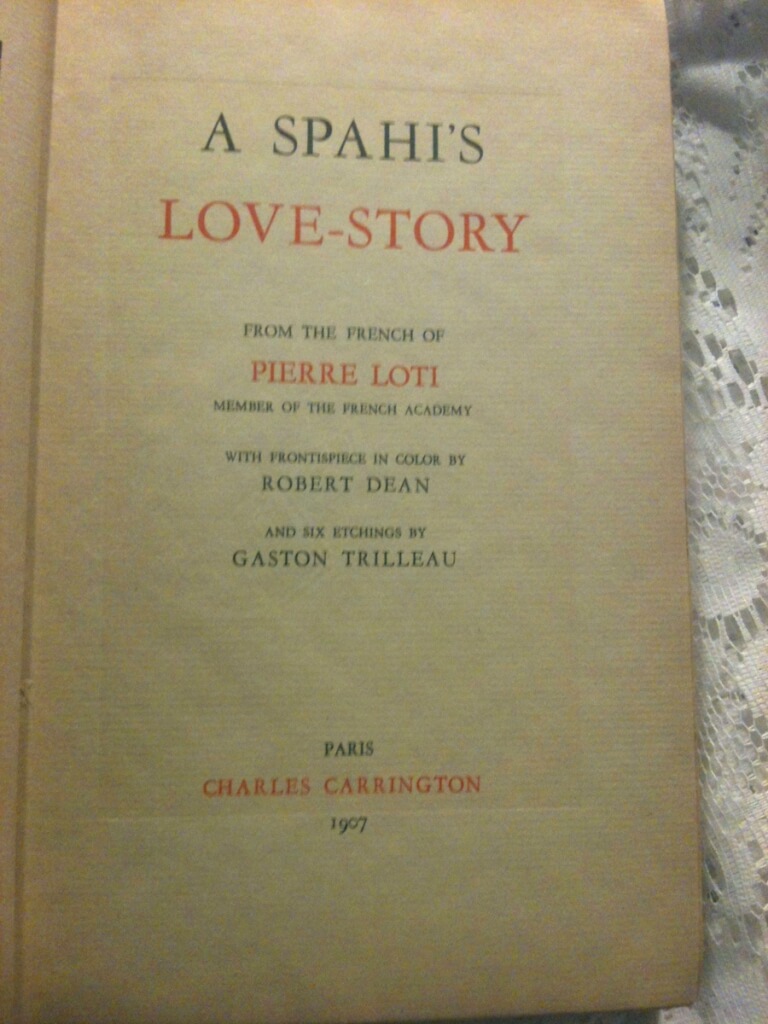
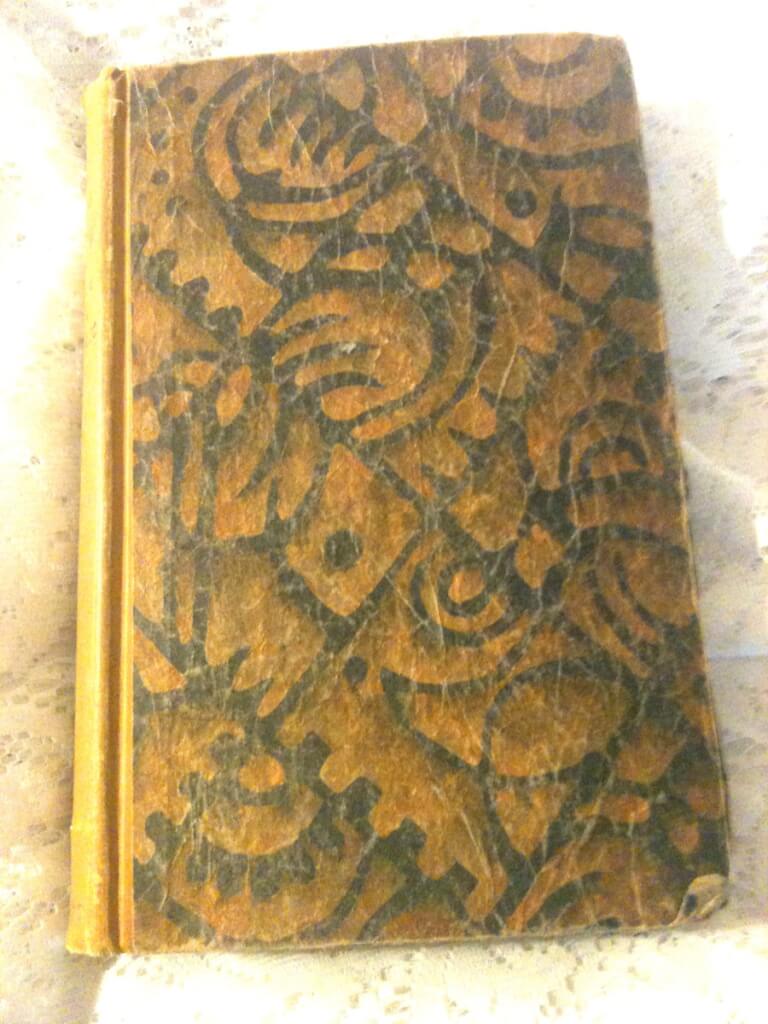 A Spahi’s Love-Story, Pierre Loti [pseud. Julien Viaud], illus. Robert Dean, illus. Gaston Trilleau (Charles Carrington, Paris, 1907, #17/1000) 9″ x 5.75″, xii+330pp, hardbound, yellow cloth and batik design paper over boards, tipped-in color frontispiece, hand-made paper, deckled edges, good+ condition Julien Viaud (1850-1923) was a French novelist and naval officer. This his third novel (originally titled “Le Roman d’un Spahi”), was originally published in 1881. It recounts the tragic story in the dark middle ages of a Turkish soldier, who fell in love with a woman from a far away culture with a very different background. Color frontispiece by Robert Dean tipped in and six etchings by Gaston Trilleau throughout the book.
A Spahi’s Love-Story, Pierre Loti [pseud. Julien Viaud], illus. Robert Dean, illus. Gaston Trilleau (Charles Carrington, Paris, 1907, #17/1000) 9″ x 5.75″, xii+330pp, hardbound, yellow cloth and batik design paper over boards, tipped-in color frontispiece, hand-made paper, deckled edges, good+ condition Julien Viaud (1850-1923) was a French novelist and naval officer. This his third novel (originally titled “Le Roman d’un Spahi”), was originally published in 1881. It recounts the tragic story in the dark middle ages of a Turkish soldier, who fell in love with a woman from a far away culture with a very different background. Color frontispiece by Robert Dean tipped in and six etchings by Gaston Trilleau throughout the book. -
 The Golden Ass of Apuleius, Lucius Apuleius Madaurensis (124-170 AD), trans. & intro Francis D. Byrne (The Imperial Press[Charles Carrington?], London, n.d. [1904?]) 8.25" X 6.25", xlix+588pp., hardbound, blue cloth boards with paper label on spine, top edge gilt, other edges deckled, just good condition, tearing to top of spine, no illustrations present. The Metamorphoses of Apuleius, which St. Augustine referred to as “The Golden Ass”, is the only Ancient Roman novel in Latin to survive in its entirety. The plot Lucius and his curiosity and insatiable desire to see and practice magic. While trying to perform a spell to transform into a bird, he is accidentally transformed into an ass. This leads to a long journey, literal and metaphorical, filled with in-set tales. He finally finds salvation through the intervention of the goddess Isis, whose cult he joins. The date of the original work is uncertain. Scholars are not sure if he wrote it in his youth or at the end of his life. He adapted the story from a Greek story written by Lucius of Patrae, however his original Greek text has long been lost.
The Golden Ass of Apuleius, Lucius Apuleius Madaurensis (124-170 AD), trans. & intro Francis D. Byrne (The Imperial Press[Charles Carrington?], London, n.d. [1904?]) 8.25" X 6.25", xlix+588pp., hardbound, blue cloth boards with paper label on spine, top edge gilt, other edges deckled, just good condition, tearing to top of spine, no illustrations present. The Metamorphoses of Apuleius, which St. Augustine referred to as “The Golden Ass”, is the only Ancient Roman novel in Latin to survive in its entirety. The plot Lucius and his curiosity and insatiable desire to see and practice magic. While trying to perform a spell to transform into a bird, he is accidentally transformed into an ass. This leads to a long journey, literal and metaphorical, filled with in-set tales. He finally finds salvation through the intervention of the goddess Isis, whose cult he joins. The date of the original work is uncertain. Scholars are not sure if he wrote it in his youth or at the end of his life. He adapted the story from a Greek story written by Lucius of Patrae, however his original Greek text has long been lost. -
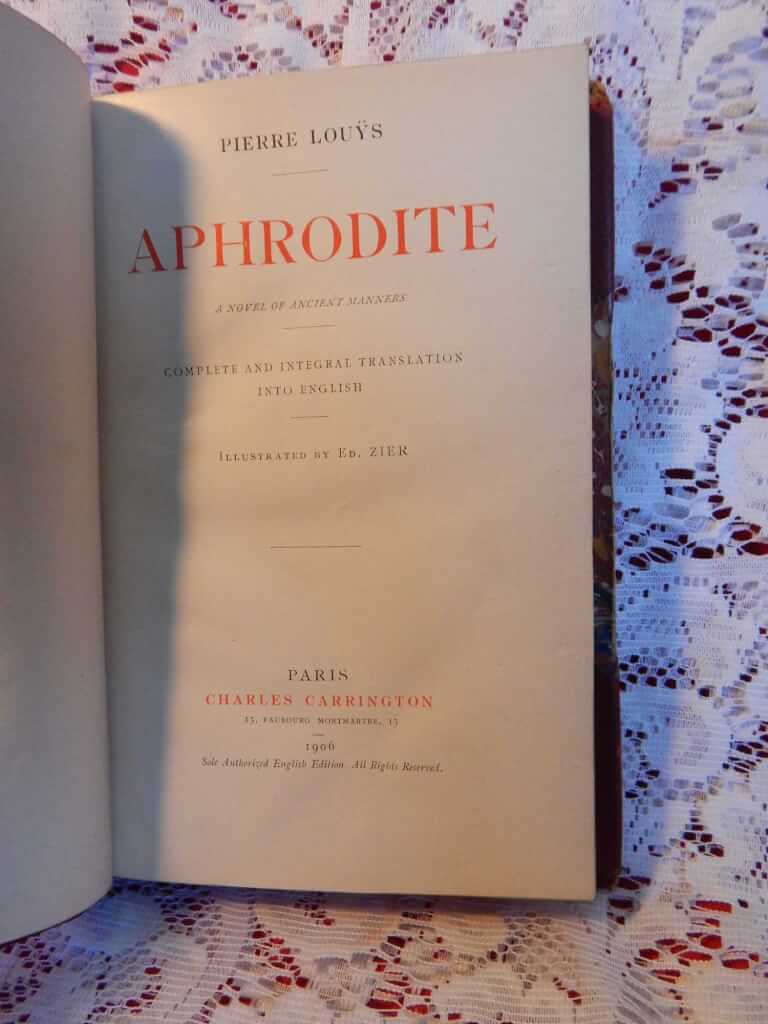
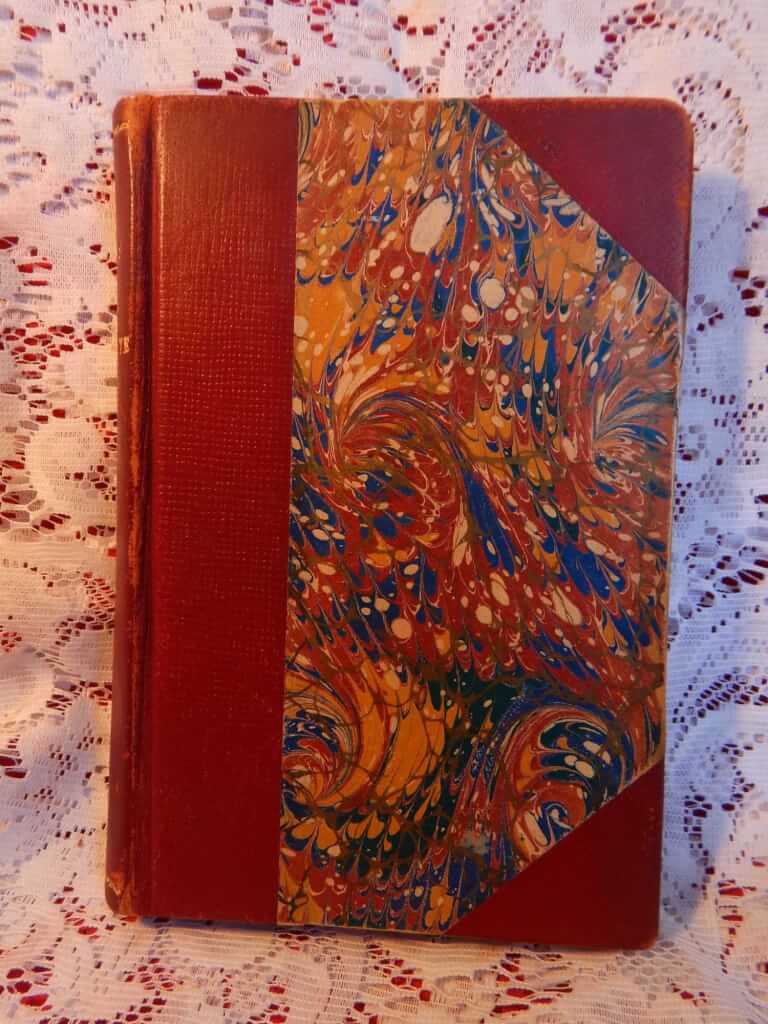 Aphrodite, a novel of ancient manners, by Pierre Louÿs, illus. Ed. Zier (Charles Carrington, 1906, first edition thus, first English translation) 5.25 x 8", 412pp, marbled boards with three quarter red cloth, gilt lettering and decoration on spine, very good condition for age, some slight bumping/scuffing Pierre Louys (1870 - 1925) was a French poet and writer, most renowned for lesbian and classical themes in some of his writings. He is known as a writer who "expressed pagan sensuality with stylistic perfection." "Aphrodite: mæurs antiques" (Ancient Manners) is a "libertine" story set in ancient Alexandria. Highlights include the loves of Chrysis, an orgy banquet ending in the crucifixion of a slave, the love of two young musician girls and the festivals of Aphrodite. "This Translation of Aphrodite was executed on the Printing Presses of Charles Herissey, at Evreux (France), for Mr. Charles Carrington, Paris, Bookseller et Publisher, and is the only complete English version extant." Édouard François Zier, (1856-1924) was a French illustrator and painter.
Aphrodite, a novel of ancient manners, by Pierre Louÿs, illus. Ed. Zier (Charles Carrington, 1906, first edition thus, first English translation) 5.25 x 8", 412pp, marbled boards with three quarter red cloth, gilt lettering and decoration on spine, very good condition for age, some slight bumping/scuffing Pierre Louys (1870 - 1925) was a French poet and writer, most renowned for lesbian and classical themes in some of his writings. He is known as a writer who "expressed pagan sensuality with stylistic perfection." "Aphrodite: mæurs antiques" (Ancient Manners) is a "libertine" story set in ancient Alexandria. Highlights include the loves of Chrysis, an orgy banquet ending in the crucifixion of a slave, the love of two young musician girls and the festivals of Aphrodite. "This Translation of Aphrodite was executed on the Printing Presses of Charles Herissey, at Evreux (France), for Mr. Charles Carrington, Paris, Bookseller et Publisher, and is the only complete English version extant." Édouard François Zier, (1856-1924) was a French illustrator and painter. -
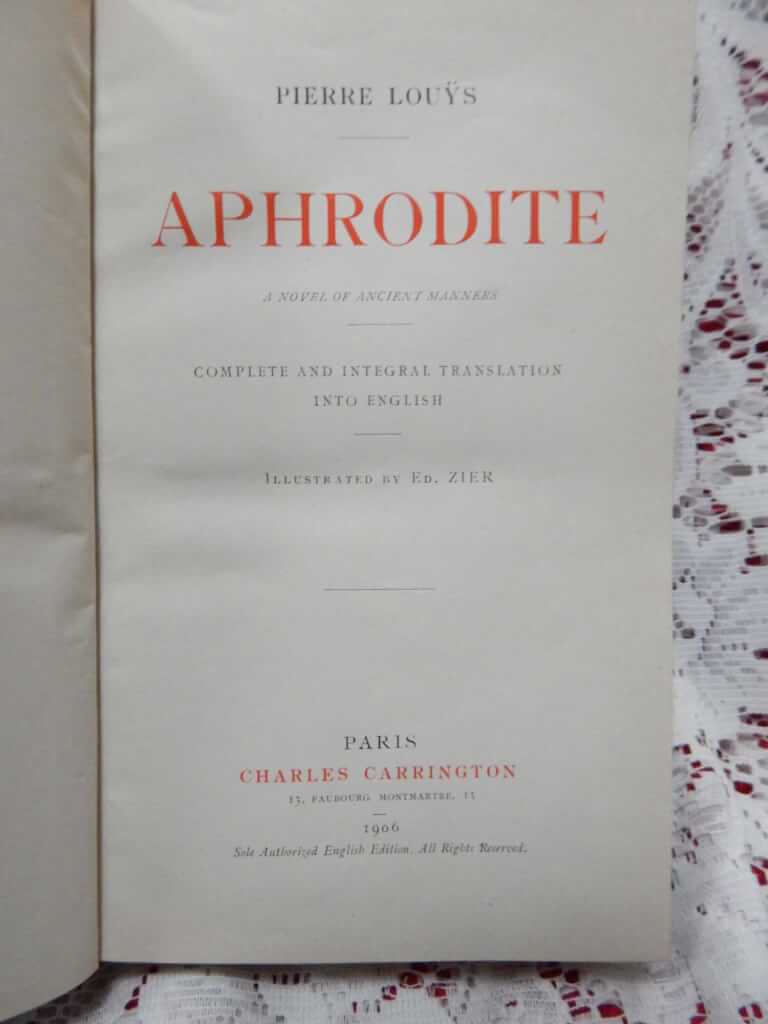
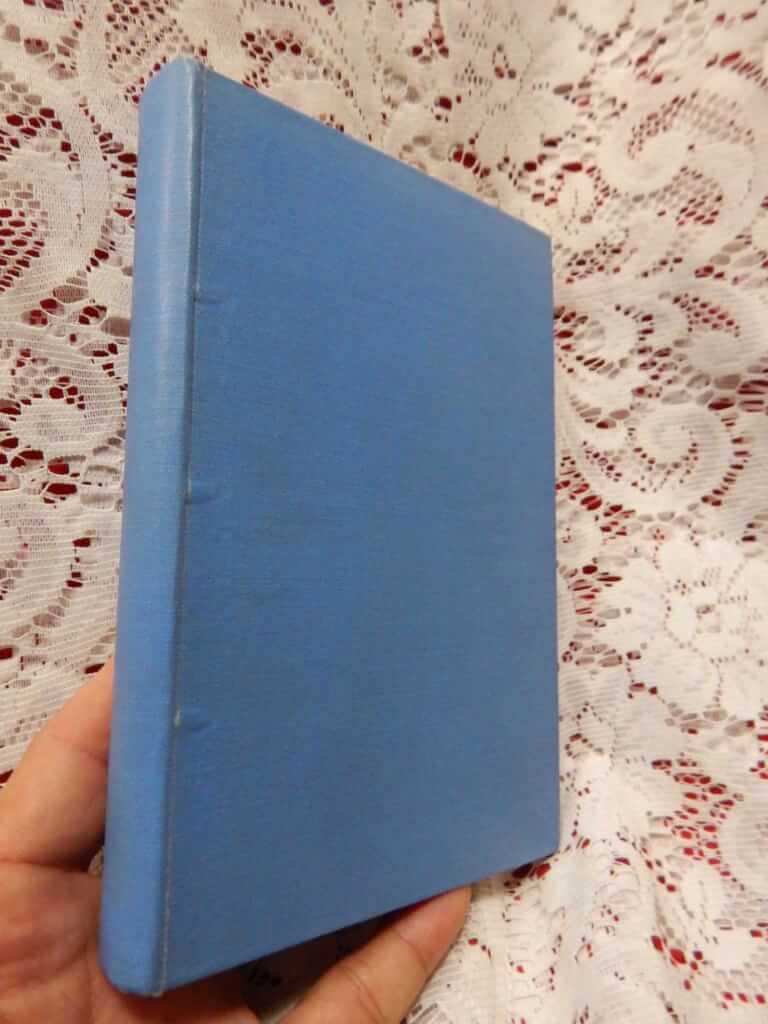 Aphrodite, a novel of ancient manners, by Pierre Louÿs, illus. Ed. Zier (Charles Carrington, 1906, first edition thus, first English translation) 5.25 x 7.75", xiv+412pp, rebound with plain blue boards, fine condition Pierre Louys (1870 - 1925) was a French poet and writer, most renowned for lesbian and classical themes in some of his writings. He is known as a writer who "expressed pagan sensuality with stylistic perfection." "Aphrodite: mæurs antiques" (Ancient Manners) is a "libertine" story set in ancient Alexandria. Highlights include the loves of Chrysis, an orgy banquet ending in the crucifixion of a slave, the love of two young musician girls and the festivals of Aphrodite. "This Translation of Aphrodite was executed on the Printing Presses of Charles Herissey, at Evreux (France), for Mr. Charles Carrington, Paris, Bookseller et Publisher, and is the only complete English version extant." Édouard François Zier (1856-1924) was a French illustrator and painter.
Aphrodite, a novel of ancient manners, by Pierre Louÿs, illus. Ed. Zier (Charles Carrington, 1906, first edition thus, first English translation) 5.25 x 7.75", xiv+412pp, rebound with plain blue boards, fine condition Pierre Louys (1870 - 1925) was a French poet and writer, most renowned for lesbian and classical themes in some of his writings. He is known as a writer who "expressed pagan sensuality with stylistic perfection." "Aphrodite: mæurs antiques" (Ancient Manners) is a "libertine" story set in ancient Alexandria. Highlights include the loves of Chrysis, an orgy banquet ending in the crucifixion of a slave, the love of two young musician girls and the festivals of Aphrodite. "This Translation of Aphrodite was executed on the Printing Presses of Charles Herissey, at Evreux (France), for Mr. Charles Carrington, Paris, Bookseller et Publisher, and is the only complete English version extant." Édouard François Zier (1856-1924) was a French illustrator and painter.

